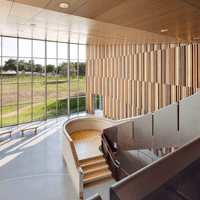Primer
In spring 2011, the Botanical Research Institute of Texas (BRIT) opened the doors to its new headquarters. It was an appropriate season to cut the ribbon on a facility that studies, houses, and celebrates flora, and the site was as appropriate. Set in the cultural center of the Fort Worth Area, the LEED Platinum building is close to museums and other civic institutions such as the Modern Art Museum, the National Cowgirl Hall of Fame, and the Fort Worth Botanic Gardens. Texas Christian University (TCU) also is nearby, and the location lends itself to a creative sense of synergy. By engaging the students at TCU to select local plant species for its green roof or by collaborating with the botanic gardens on programming, BRIT is interconnected with the cultural geography of the area.
The site also was a natural choice because of Trinity Park’s location immediately to the east, providing prairie views from the facility. However, an early challenge was an existing building on-site—a health center—that required demolition. Because of this, the project was on hold from summer 2007 to summer 2008. When it resumed, the project’s design architect, H3 Hardy Collaboration Architecture, was faced with the challenge of designing a building that would house sensitive dried plant specimens as well as provide space for essential organizational functions and graphics that communicated the institute’s mission.

BRIT has students from nearby Texas Christian University help select plants for the green roof to foster its community engagement. Photos: Chris Cooper
Planning
The strength of the new BRIT building, and the lattice that held it together throughout the build process, was the collaborative nature of the project team. “There are always challenges—budget, schedule—but no one ever lost sight of what they were trying to achieve, and it produced amazing results,” says Jonathan Posnett, creative director at Two Twelve, a New York-based graphic design consultancy that was responsible for not only the design but the development of the signage in and around the headquarters.
The large, interpretive graphic program was integral to BRIT’s space because of the new importance the organization placed on communicating its message to visitors and the public. Daria Pizzetta, a partner at H3 Hardy, echoed the idea that the closeness of the team was the bedrock of its success. “No one ever presented a problem without also presenting a possible solution,” she says. “We all just loved each other.”
H3 Hardy was not only the project architect but also a part of programming. The team worked with BRIT before any drawings were made to develop what kind of space it envisioned. Importantly, that space would need to house conferences, educational programs, presentations, a library, and, crucially, up to two million dried plant specimens.
Process
During the time the BRIT building was on hold, various project costs decreased, enabling the structure, in the end, to surpass LEED Gold certification and reach LEED Platinum. The geothermal field located in the parking lot was already planned, but additional features included natural materials such as pure wool carpet and a rooftop photovoltaic array. These features helped the project get all 17 possible points in LEED’s Energy and Atmosphere category.
The BRIT headquarters is composed of two intersecting forms or structures, the “Think Block,” which houses all the administrative, research, and public areas, and the “Archive Block,” which contains the herbarium and the library. The herbarium is where all the sensitive plant specimens are located, and the climate is controlled to keep these plants viable. It is cool and dry. Researchers spending the better portion of a day there need at least a jacket. The Archive Block also will eventually become a living form because the exterior was designed to accommodate vines woven through stainless-steel guide wires.
According to staff, the BRIT’s most popular feature is the lighting. The building was designed to bring in a large amount of sunlight, made possible by a large glass façade on the north side of the building and every office having a window. “We wanted the building to be outward-looking,” Pizzetta says. “In fact, the sunlight is so good the staff rarely turns on their lights during the day.” A final attractive feature is the landscape design by Balmori Associates. “What makes the whole project sing is the marriage between landscape and building,” Pizzetta says.
After a year of being open to the public, BRIT’s goals and intent continue to be met by its new home, a building that successfully aids research and education as well as communicates to the public about the work it does. Pizzetta says, “All of the client’s feedback was about having a building that reflected their personality and their mission.”


